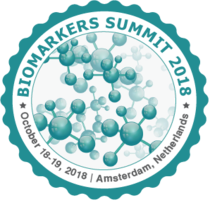
Vincent van Ginneken
Erasmus Medical Centre, Netherlands
Title: The Discovery of Two Novel Biomarkers in a High-Fat Diet C56bl6 Obese Mouse Model for Non-Adipose Tissue: A Comprehensive LCMS Study at Hind Limb, Heart, Carcass Muscle, Liver, Brain, Blood Plasma and Food Composition Following a Lipidomics LCMS-Based Approach
Biography
Biography: Vincent van Ginneken
Abstract
This lipidomics study was designed to find via a high-fat (HF) diet induced insulin resistant (IR) and/or type-2 diabetes (T2DM) C57Bl/6 mouse model potential novel biomarkers. Major aiming was to find following this lipidomics based approach novel safe biomarkers applicable for humans with IR/T2DM that can be used in the assessment of diagnosis, intensive treatment, clinical use and new drug development. In addition, the biomarker has to be found in blood-plasma simultaneously while it is not a component of the HF-diet. Reversed phase liquid chromatography coupled to mass spectrometry (LCMS) were used to quantify and qualify the rearrangement and repartitioning of fat stores in the heart, hind limb, carcass muscle, liver, brain and blood plasma of this mice model following a systems biology lipidomics based approach. Two potential biomarkers were found for this HF-diet mouse model. The first biomarker was a 20:3 cholesteryl-ester (20:3-ChE) which significantly increased (P≤0.016) in the fatty heart with 1317% while it rose very significantly (P≤0.00001) in blood plasma with 1013% in the HF diet group in comparison to the control-group (Co). The second biomarker was a 36:1 phosphatidylcholine (36:1-PC), which rose significantly (P≤0.025) mainly in heart muscle with 400% while concentrations increased significantly strongly (P≤0.002) in blood plasma with 1493% in the high-fat diet vs. Co. As an earlier defined prerequisite, both compounds were not found in the food. The 20:3-ChE biomarker (dihomo-γ-linolenic; 20:3 n-6) has been classified as a potential type 2 diabetes biomarker (T2DM) in a human cohort of the Uppsala Longitudinal Study of Adult Men (ULSAM). In addition, we give a biochemical explanation for the 36:1-PC as hypoxic biomarker for cardiovascular diseases (CVD) diagnosis and therapy. Both biomarkers are interesting candidates for further validation in human cohorts.

